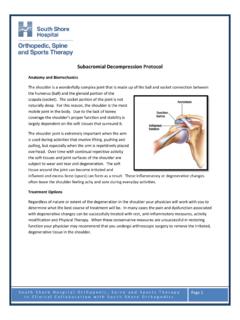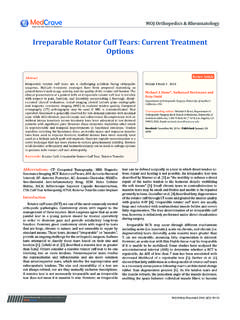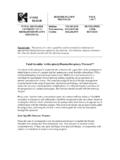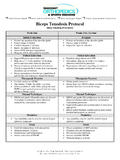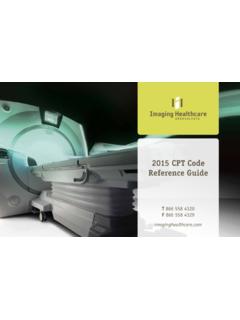Transcription of Rotator Cuff Repair Protocol - South Shore Hospital
1 Rotator cuff Repair Protocol Anatomy and Biomechanics The shoulder is a wonderfully complex joint that is made up of the ball and socket connection between the humerus (ball) and the glenoid portion of the scapula (socket). The socket portion of the joint is not naturally deep. For this reason the shoulder is the most mobile joint in the body. Due to the lack of bony coverage the shoulder's proper function and stability is largely dependent on the soft tissues that surround it. The Rotator cuff is a group of four tendons that attach to the ball of the shoulder joint.
2 They surround the ball much like the cuff of a sleeve fits snuggly around the wrist. When the arm is moved away from the body or over the head the tendons act to hold the ball in the socket correctly so that smooth fluid motion can be achieved. When one or more of these tendons is torn it becomes very difficult to use the arm to complete even the most basic activities of daily living. A tear in the Rotator cuff can happen during a trauma to the shoulder or simply over time with repetitive, stressful activity. Treatment Options Regardless of how the tendon is torn your physician will work with you to determine what the best course of treatment will be.
3 In many cases a small, partial thickness tear can be treated conservatively. This may include Physical Therapy, anti-inflammatory medication, rest, and activity modification. When conservative measures are unsuccessful in restoring function you and your physician may elect to have the torn tendon repaired. South Shore Hospital Orthopedic, Spine and Sports Therapy Page 1. in Clinical Collaboration with South Shore Orthopedics Surgery Rotator cuff Repair surgery can now be performed arthroscopically and is in most cases an outpatient day surgery procedure.
4 This means that it is very rare to have to spend the night in the Hospital . If damage to the Rotator cuff is extensive your surgeon may have to use an open incision rather than an arthroscope to complete the procedure. Regardless if the procedure is open or arthroscopic all patients will likely be home on the same day as surgery. Recovery/Time off Work Having a torn Rotator cuff repaired is not an easy undertaking. It is very important that the patient knows that the recovery process is difficult and time consuming.
5 He or she must be an active participant during this process, performing daily exercises to ensure there is proper return of range of motion and strength. There is a large amount of variability in the time it takes to fully recover from this procedure. It is usually estimated that it will take at least six months to feel as though you have completely regained the use of your arm. Some cases may take as long as a year to make a full recovery. People with desk jobs should plan to take at least one week off from work.
6 Manual laborers will likely be out of work for at least six months. Recovery is different in each case your individual time table for return to activities and work will be discussed by your surgeon during post operative office visits. Post Operative Visits Your first post-op visit to the doctor's office will be approximately 10 days after the operation. At this visit your stitches will be removed and you will review the surgery with the surgeon or his assistant. At this time you will most likely be cleared to make an appointment to begin rehab.
7 You should also plan to check in with your surgeon at 6, 12, and 24 weeks after the operation. At Home You may remove your post-op dressing two days after the operation and replace it as needed. Do not remove the tape (steri-strips) that are across your incision. Allow them to fall off on their own. You may shower after two days, but use a water-tight dressing until your sutures are removed. Bathing without getting the shoulder wet or sponge baths are a good alternative. You may wash under the affected arm by leaning forward and letting the arm dangle.
8 Do not attempt to actively move your arm at the shoulder joint for any reason until cleared by your physician or therapist. You may move your hand, wrist and elbow when your arm is out of the sling, but do not lift or carry anything with your operated arm until cleared your physician or therapist. South Shore Hospital Orthopedic, Spine and Sports Therapy Page 2. in Clinical Collaboration with South Shore Orthopedics Driving You will be permitted to drive after surgery following approval from your doctor. Generally you should expect to not be able to drive for four to six weeks following the operation.
9 You are not permitted to drive while wearing your sling or while on narcotic medication. Medication Your surgeon will prescribe you pain medicine after the operation. You may not take anti-inflammatory medication like Advil, Ibuprofen, or Aleve for at least 12 weeks after the operation as it may compromise the healing tendon. You may take Tylenol as needed. Please call the doctor's office if you have any questions regarding medication. Ice You must use ice on your shoulder after the operation for management of pain and swelling.
10 Ice should be applied 3-5 times a day for 10-20 minutes at a time. Always maintain one layer between ice and the skin. Putting a pillow case over your ice pack works well for this. Sling You will be provided with a sling to wear after the operation. You should wear this sling all of the time (even for sleeping) and should remove it only when bathing/showering, or to do your exercises. Most patients will be required to use a sling for 4-6 weeks after the operation. Sleeping You should sleep with your sling on and a pillow propped under your arm to keep it slightly away from the body.
